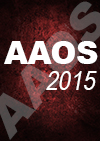
AAOS 2015: Investigating tourniquet strategies in total knee arthroplasty

AAOS 2015: Investigating tourniquet strategies in total knee arthroplasty
How Can We Use Tourniquet More Properly During Total Knee Arthroplasty?
Did you know you're eligible to earn 0.5 CME credits for reading this report? Click Here
CONFERENCE ACE REPORTS
This ACE Report is a summary of a conference presentation or abstract. The information provided has limited the ability to provide an accurate assessment of the risk of bias or the overall quality. Please interpret the results with caution as trials may be in progress and select results may have been presented.
Synopsis
This trial conducted randomized sub-studies on patients undergoing total knee arthroplasty with a pneumatic tourniquet. The first study randomized 160 patients to the use of either low (SBP + 120 mmHg) or high (SBP + 150 mmHg) tourniquet pressures with the purpose of quantifying an effective and safe tourniquet pressure. Following the intraoperative assessment of the quality of the surgical field,...
To view the full content, login to your account,
or start your 30-day FREE Trial today.
FREE TRIAL
LOGIN
Forgot Password?
Explore some of our unlocked ACE Reports below!

Learn about our AI Driven
High Impact Search Feature
Our AI driven High Impact metric calculates the impact an article will have by considering both the publishing journal and the content of the article itself. Built using the latest advances in natural language processing, OE High Impact predicts an article’s future number of citations better than impact factor alone.
Continue



 LOGIN
LOGIN

Join the Conversation
Please Login or Join to leave comments.